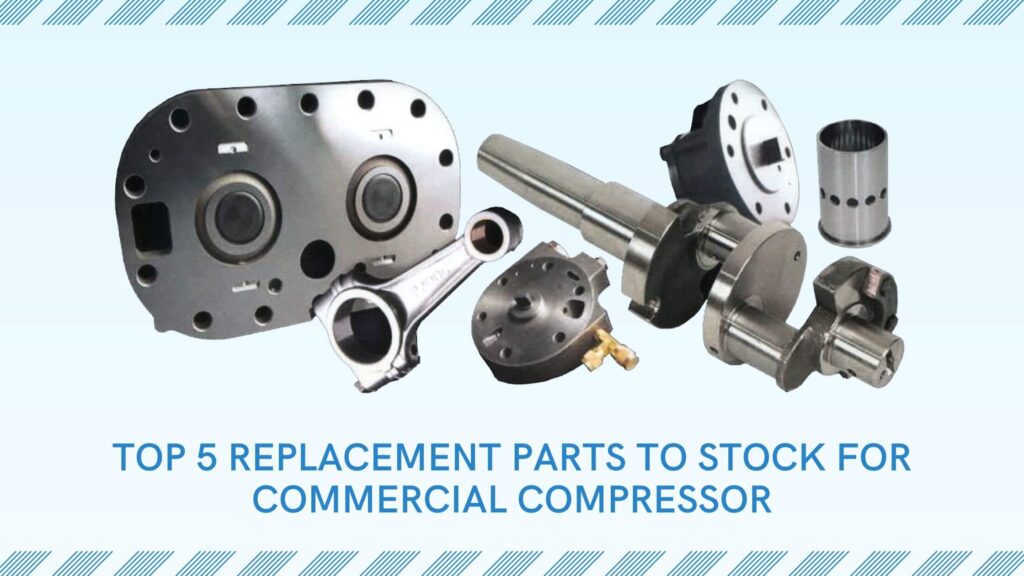Any company that depends on the service of a compressor should have compressor spare parts available, regardless of whether you have an industrial HVAC system or a sizable refrigeration system. Spare components can frequently be the difference between a problem being fixed right away and a prolonged period of system downtime. Additionally for improving your compressor’s performance and preserving top efficiency, spare parts are essential.
Having replacement parts is still a good idea even if you have a backup commercial compressor ready to use. A commercial compressor should last between eight and ten years if it is properly maintained. Gaskets, polyester and alkabenzine oils, suction and discharge service valves, and a wide variety of other commercial compressor replacement parts are all kept in stock at JEC. However, you might be curious about which components are truly the most crucial for you to have on hand.
We have identified trends in the typical mechanical problems that our customers encounter based on our years of experience with all of the leading commercial compressor brands globally. We therefore created this “short list” of replaced parts you should keep always for your compressor’s repair and maintenance.
Bearings
A commercial compressor has bearings spread out all over it. Depending on the compressor’s design and intended usage, different types are used. For instance, hydrodynamic or journal bearings are used in reciprocating compressors. These have supply holes around the circumference and are sized to allow oil to flow through easily, preventing overheating. Although replacing bearings in the field can be challenging, it is a good idea to have some on hand in case the compressor needs to be brought into a usable state.
Unloaders
When the pressure that has built up inside the cylinder head assembly or the discharge line is released after each cycle, compressors perform at their peak efficiency. The start-up procedure becomes more loaded as pressure increases, increasing the motor’s starting torque. The unloader valve is a tiny part, typically measuring only three to four inches. It attaches to the discharge line or the cylinder head assembly via tubing that is terminated with the proper fitting. By allowing for pressure escape, it serves the primary purpose of reducing the initial load. Additionally, it can produce a more precise method of capacity control in HVAC systems that work with a wide range of thermal loads (responding to occupancy, lighting conditions, and so on). The unloader can lead to fewer compressor cycles and greater energy efficiency in this case.
Valve Parts
The valve plates of the compressor act as seals between various pressure zones. When the appropriate pressure differences between two zones are obtained, they open. This enables efficient gas movement during the compression cycle from areas of high to low pressure.
The system must be completely equipped with the appropriate valve plates in order for the refrigerant to flow properly throughout the whole cycle, even if the compressor itself undertakes the initial effort of increasing the pressure of the refrigerant gas. They are made with strong cyclic and impact fatigue resistance in mind. One of the most frequent problems that lower compressor efficiency is damage to the valve plates. It may potentially result in the compressor failing. Extra valve plates are always useful to have on hand, but if you use reciprocating compressors, they become very necessary.
Piston Rings
Another component that is crucial for a reciprocating compressor is the piston ring. They are the part that really comes into touch with the cylinder’s walls. Specific additives are added to each piston ring to enhance its performance characteristics. They must be kept well-oiled and quickly have old, worn out piston rings replaced in order for them to function as intended. Despite the fact that piston rings are not often replaced in the field, having some on hand is still a smart idea.
Crankcase Heaters
In order to stop refrigerant from migrating and from interacting with the lubricating oil, crankcase heaters are utilized. They accomplish this by making sure the oil is kept at a high enough temperature. A long, thin electrical heater connected to an adjustable strap makes up this straightforward part. Regardless of the exact size of the crankcase housing, the heater may be positioned around it. If the heater breaks down, refrigeration migration will cause the crankcase pressure to drop when the engine starts up again. This results in foaming in the crankcase and can seriously harm the compressor.
JEC is a major supplier of refurbished compressors and zero-defect compressor spares. Thanks to energy-efficient, economical, and high-performing compressor components, JEC has helped clients throughout the world save considerable cost over the course of its 35 years of robust business. For the best compressor replacement parts, visit the website or dial 9821020357 right away!


